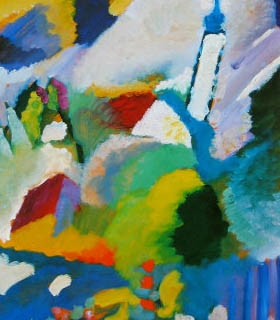Each color lives by its mysterous life
Everything about Wassily Kandinsky

1910_Oil on cardboard
Biography
Wassily Kandinsky (16th December, 1866 - 13th December, 1944) was an influential Russian painter and art theorist. He is credited with painting the first purely abstract works. Born in Moscow, Kandinsky spent his childhood in Odessa. He enrolled at the University of Moscow, studying law and economics. He was offered a professorship at the University of Dorpat due to succeed in his profesion. Then, he began painting studies such as life-drawing, sketching and anatomy at the age of 30.Painting was the key in Kandinsky’s career life. All of his paintings convey the spirituality and the depth of human emotion. Kandinsky use abstract forms and colors that transcended cultural and physical boundaries to express his idea.
1913_Oil on canvas
Kaninsky's career
On the other hands, Kandinsky looked at music as the most transcendent form of non-objective art. For him, musicians could evoke images in audiences’ minds with sounds. Therefore, he produced similarly object-free paintings that is rich of spirituality. He believe that this style of painting would bring sounds and emotions through a unity of sensation.Both artistic and theoretical in Kandinsky’s artwork played a large role in the philosophic foundation for after modern movements. Its variants like color field painting became famous in particular Abstract Expressionism.
After returning to Germany, Kandinsky accepts an invitation of Walter Gropius, the founder of the well-known Bauhaus ,the Higher school of construction and art designing. Kandinsky also worked much and experimented with color. Kandinsky’s works again underwent changes: individual geometrical elements increasingly entered the foreground, his palette was sated with cold color harmonies. At times, are perceived as a dissonance, the circle is used differently, as a sensual symbol of perfect form.
